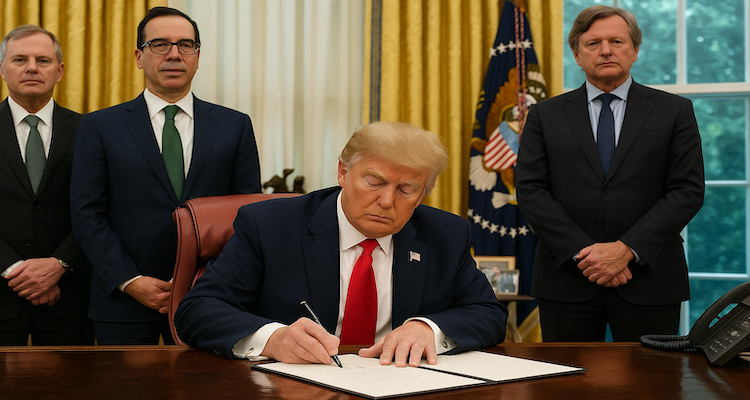Trump’s Steel and Aluminum Tariffs: A Trade Shake-Up with Global Consequences
President Donald Trump plans to introduce 25% tariffs on steel and aluminum imports, sparking trade tensions with global partners. Find out the impact and responses.
Trump’s New Tariffs on Steel and Aluminum: A Trade War on the Horizon?
President Donald Trump is set to impose a new 25% tariff on all steel and aluminum imports, escalating trade tensions with major U.S. partners. The decision, which comes on top of existing duties, signals a renewed focus on protecting American industries but risks retaliation from key global economies. With the European Union (EU) already hinting at countermeasures and Trump vowing further reciprocal tariffs, the move could ignite a multi-front trade dispute.
The Immediate Impact on Markets
The announcement sent U.S. steel and aluminum stocks soaring. Companies like Nucor and U.S. Steel saw their shares rise by 4% to 7%, while Cleveland-Cliffs surged 15%. Similarly, Century Aluminum and Alcoa experienced gains of 13% and 4%, respectively. Conversely, European and Asian steelmakers saw their stock prices dip, reflecting concerns over reduced access to the lucrative U.S. market.
The Rationale Behind Trump’s Tariffs
Speaking aboard Air Force One en route to the Super Bowl in New Orleans, Trump justified the tariffs by emphasizing the need for fair trade practices. “If they charge us, we charge them,” he declared, underscoring his long-standing commitment to leveling the playing field. The largest sources of U.S. steel imports—Brazil, Canada, Mexico, South Korea, and Vietnam—are now bracing for economic disruptions.
Canada, which supplies nearly 79% of America’s primary aluminum imports, expressed concerns over the move. Canadian Innovation Minister Francois-Philippe Champagne took to social media to highlight the critical role Canadian metals play in key U.S. industries, from defense to shipbuilding and auto manufacturing.
A Look Back: Trump’s Previous Tariffs and Their Impact
During his first term, Trump introduced similar tariffs—25% on steel and 10% on aluminum. However, he later granted exemptions to strategic allies, including Australia, Brazil, Canada, and Mexico. President Joe Biden further negotiated duty-free quota deals with the EU, Britain, and Japan. Now, with fresh tariffs on the table, industry leaders warn that increased costs for raw materials could ultimately harm U.S. manufacturers and consumers.
Global Reactions and Potential Countermeasures
European Union’s Warning
The European Commission swiftly criticized the new tariffs, stating that they lacked justification. “We will react to protect the interests of European businesses, workers, and consumers,” an EU spokesperson declared. With European steelmakers accounting for 15% of U.S. steel imports, companies like ArcelorMittal and Voestalpine saw their shares slip amid the uncertainty. German firms Thyssenkrupp and Salzgitter also expressed concerns over potential economic fallout.
South Korea Weighs Its Response
In South Korea, officials convened urgent meetings with steel producers to assess the impact of the tariffs. Hyundai Steel saw its shares decline by nearly 3%, mirroring broader concerns among South Korean manufacturers.
Strategic Considerations: U.S. Steel Industry and Foreign Investments
While Trump has positioned the tariffs as a way to revive American manufacturing, experts warn of unintended consequences. U.S. steel mill capacity utilization spiked above 80% in 2019 following Trump’s initial tariffs but later declined due to China’s continued dominance in the global market. Some facilities that reopened amid previous tariff protections, such as a Missouri aluminum smelter, have since been shuttered.
Trump also addressed the ongoing debate over foreign ownership in U.S. steel companies, specifically mentioning that Japan’s Nippon Steel would be permitted to invest in U.S. Steel but would not be allowed a majority stake. “Tariffs are going to make U.S. Steel very successful again,” Trump asserted, reinforcing his economic nationalist stance.
The Broader Implications for Global Trade
Beyond steel and aluminum, Trump has signaled a broader push for reciprocal tariffs. He has long criticized the EU’s 10% tariff on auto imports, significantly higher than the U.S. rate of 2.5%. However, the U.S. maintains a 25% tariff on imported pickup trucks, which benefits domestic automakers like General Motors, Ford, and Stellantis.
According to World Trade Organization (WTO) data, the U.S. trade-weighted average tariff rate currently stands at 2.2%, compared to 12% in India, 6.7% in Brazil, and 5.1% in Vietnam. These disparities have fueled Trump’s push for a more aggressive trade policy.
Industries at Risk: American Whiskey and the Fallout of Retaliatory Tariffs
Trade disputes often lead to retaliatory measures, and U.S. industries beyond steel and aluminum could soon feel the effects. Chris Swonger, CEO of the Distilled Spirits Council of the United States, warned that new steel tariffs could provoke the EU to impose higher duties on American whiskey. “A 50% tariff on America’s native spirit would be devastating for the 3,000 small distilleries across the country,” he cautioned.
What’s Next? Trump’s Trade Policy in Focus
As Trump prepares to roll out reciprocal tariffs in the coming days, all eyes are on global leaders’ responses. His administration has already threatened a 25% tariff on all imports from Canada and Mexico, citing concerns over drug and migrant flows across the border. While Trump temporarily paused these tariffs after securing border security concessions, he insists that further action is needed. “Something has to happen, it’s not sustainable,” he told Fox News. “And I’m changing it.”
Final Thoughts: A Balancing Act Between Protectionism and Economic Stability
While the new tariffs align with Trump’s protectionist economic policies, they pose significant risks. Higher raw material costs could strain U.S. manufacturers, while retaliatory tariffs from global partners could dampen economic growth. As the trade landscape shifts, businesses and policymakers alike must navigate an increasingly uncertain environment.
For now, the world watches closely as Trump reshapes U.S. trade policy once again—potentially setting the stage for a new era of economic confrontation.
Source: (Reuters)
(Disclaimer: The information presented in this article is based on publicly available sources and is subject to change. Readers are encouraged to consult official government websites or trade organizations for the latest updates.)
Also Read: Trump Criticizes Ceasefire as Hostage Release Sparks Renewed Tensions











